For such a basic food, eggs have caused quite a ruckus. Long considered the enemy of healthy hearts everywhere, eggs are actually one of nature’s purest forms of nutritional goodness. Inside its smooth, fragile shell, an egg contains most of the nutrients our bodies need, including a rich array of proteins, vitamins, minerals and healthy fats.
Worried about eggs spiking your cholesterol levels? Don’t be. Research has exonerated eggs on that count. (For more on that, visit “Cholesterol Reconsidered“.)
It is wise to be choosy about where your eggs come from, though, since their healthy-fats profile, flavor and texture are all directly affected by how the birds are raised.
Pasture-raised eggs — with their rich, buttery yolks and tender, flavorful whites — are luscious to eat. But only if you know how to cook ’em right. As food writer M.F.K. Fisher put it, “eggs have been massacred for as long as people knew about pots and pans.”
Read on to learn the secrets of bringing out the best in this endlessly adaptable ingredient.
Quick and Easy
Hard Cooked/Soft Cooked: Place whole eggs in a heavy saucepan and cover with cold water. Bring the water to a boil, cover the pan and remove from heat. Allow the eggs to sit in the covered pan for 10 minutes. (For a soft-cooked egg, allow the eggs to sit in the pan for three to four minutes.) See “How to Boil an Egg” for our four-step, fuss-free, easy-to-peel eggs.)
Scrambled: Beat two eggs until smooth and season with salt and pepper. Over medium-low heat, preheat a heavy-bottomed skillet and add 2 teaspoons of butter. When the butter bubbles, add eggs, allowing them to set for about 20 seconds before gently stirring in a little more butter to make the eggs creamy. Cook until the eggs are just set.
Fried/Over Easy: Heat a heavy-bottomed skillet over low heat and melt 1 tablespoon butter in the skillet until it bubbles. Crack eggs into the skillet and season with salt and pepper. Occasionally spoon the melted butter over the whites while cooking. After about three to five minutes over low heat, the whites should be set and the eggs will be ready. (For “over easy,” flip after three minutes on one side and cook for another minute or two on the other side.)
Poached: Fill a shallow, wide pan halfway with water, add a teaspoon of vinegar and bring to a simmer. Crack an egg into a cup and set aside. Briskly stir the water in one direction to create a vortex, then stop stirring and pour the egg into that vortex. Simmer gently for three to four minutes, until the egg is just set. Lift the egg out of the water with a slotted spoon. (Too fussy? Consider buying a stainless-steel or silicone egg-poaching cup.)
Aioli: Start with one egg yolk in a bowl and add the juice of half a lemon, salt, pepper, one clove minced garlic and a pinch of saffron (optional). Whisk until smooth, then, drop by drop, add 1/2 cup olive oil, whisking constantly to emulsify the oil with the egg mixture. (Or try this recipe for simple Lemon Aioli.)
Basted: Heat a heavy-bottomed skillet over medium-low heat and melt 1 teaspoon of butter before cracking the egg into the pan. When the egg white is beginning to set, add 1/4 cup liquid (try chicken or vegetable stock or a mixture of salsa and water). Cover and cook over low heat for three to five minutes, until egg is set to your preference.
Nutrition Know-How
- Eating one or two eggs a day does not significantly change blood cholesterol levels — in fact, it has even been shown to improve the ratio of LDL and HDL cholesterol. Some experts contend that overcooking or exposing the yolks to air for too long leads to oxidized cholesterol, though, which does irritate blood vessels and trigger the formation of plaque. So, avoid products that list “powdered whole eggs” as an ingredient, and try not to overcook scrambled eggs and omelets.
- Raw eggs, followed by soft-cooked eggs, maintain higher levels of perishable nutrients than cooked eggs. Raw eggs do carry risks, however. Raw egg whites contain a glycoprotein called avidin, which prevents the body from absorbing the B vitamin biotin. Salmonella, while rare, is known to come from chickens raised in unsanitary conditions. One more reason to know the source of your eggs.
- In one study, eggs from pasture-raised hens, as opposed to conventional, factory-farmed eggs, were found to have about four to six times the amount of vitamin D, seven times more beta-carotene, three times more vitamin E, and twice the omega-3 fats.
- Egg yolks contain choline, an essential nutrient grouped with B-complex vitamins that supports brain health and the nervous system. Research suggests that about 90 percent of Americans are choline deficient.
- Most people’s health improves from eating eggs, but it’s important to remember that certain people are allergic to them. (Some physicians hypothesize that egg allergies result from overcooking, which changes the chemical shape of the food’s protein.)
Kitchen Tricks
- Use the right tools. A heat-proof rubber spatula and a heavy, high-quality pan are essential. Some people swear by a well-seasoned cast-iron pan; others don’t like the slightly metallic flavor the pan imparts. A good alternative is a stainless-steel pan; just be sure to use extra fat so the egg doesn’t stick. (Many experts warn against potentially toxic nonstick pans.)
- Got a little bit of shell in your cracked eggs? Use a larger piece of eggshell to scoop it out; you’ll find it works much better than using a spoon or finger.
Shopping and Storage Tips
- Whenever possible, seek out pastured, organic eggs from a source you trust. Says chef Marie Simmons: “They are so much more flavorful, and they are much fresher tasting.” Conventional supermarket eggs are almost always from caged hens.
- The color of an eggshell — brown, white, etc. — depends on the breed of the chicken and does not indicate nutritional value or quality.
- Do not wash eggs before storing. Water removes a very thin protective layer of protein that covers the shell and helps them last longer.
- Keep eggs in the coldest part of your refrigerator for up to a month. Do not freeze.
Recipes
Readers sometimes ask us why we don’t publish calorie, carb and fat counts with our recipes. The answer: We believe that as long as you’re eating primarily whole, healthy foods — an array of sustainably raised vegetables, fruits, legumes, meats, eggs, whole-kernel grains (and full-fat dairy if you can tolerate it) — you don’t need to worry much about the numbers. — Eds.
Huevos Rancheros
This classic Mexican breakfast is a cinch to whip up using high-quality jarred salsa and canned black beans.

Serves | four
Ingredients
- 8 corn tortillas
- 8 eggs
- Butter
- 1 cup red or green prepared salsa
- 1 15-ounce can seasoned black beans
- 1/4 cup Cotija or feta cheese
- 1 avocado, peeled and cut into wedges
- 1/2 cup cilantro, chopped
Directions
- Warm the tortillas directly over the gas fire or in a dry skillet and keep warm while you prepare the eggs according to your preference (basted is especially nice, but you can also gently fry or scramble them). Warm the salsa and the black beans.
- Arrange an egg on each tortilla, and top with the salsa and a crumble of Cotija cheese.
- Serve with the black beans and a side of avocado and chopped fresh cilantro, if you like.
Lyonnaise Salad
The soft yolk of the poached egg becomes part of the salad dressing in this deliciously simple salad. Chop the egg and toss with the greens before eating, if desired. Sub in other sturdy, bitter salad greens, such as radicchio, endive and chicory.
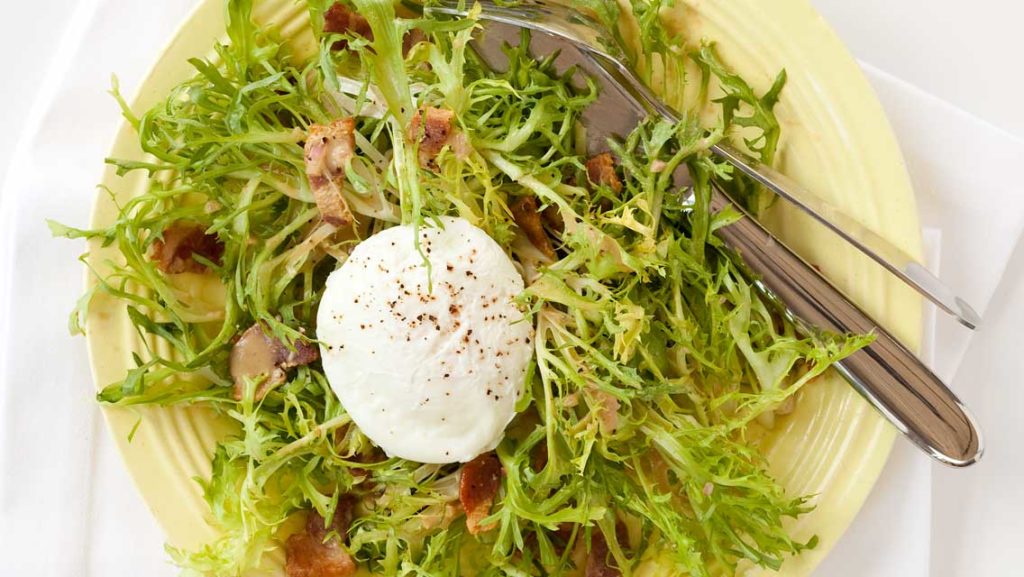
Serves | four
Ingredients
- 4 slices thick-cut, nitrate-free, organic or pasture-raised bacon, cut into 1/4-inch pieces
- 1 tbs. minced shallot
- 1 tbs. Dijon mustard
- 2 tbs. sherry vinegar
- Salt and freshly ground black pepper to taste
- 1 head friseé lettuce, washed and chopped roughly
- 4 eggs, poached
Directions
- Cook the bacon pieces in a skillet over medium heat until crispy. Remove the bacon, drain off half the fat, and add the minced shallot.
- Cook over low heat until shallot is soft. Drain off more bacon fat, if you like.
- Turn off the heat and stir in the mustard, vinegar and bacon, and season with salt and pepper to taste.
- Toss the bacon dressing with the friseé and divide into four bowls.
- Place a poached egg on top of each bowl of greens.
Honey & Vanilla Bean Crème Caramel
Fresh vanilla bean gives this crème caramel an exceptional aroma. Serve with caramelized pear slices on the side, or simply add some fresh berries.
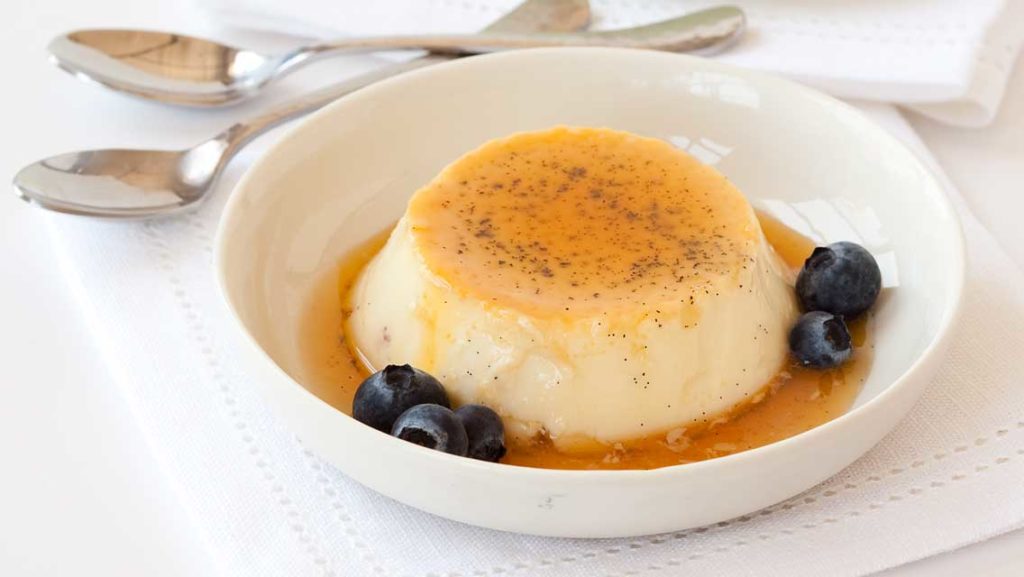
Makes | six servings
Ingredients
- 1/2 cup honey, plus 1/3 cup reserved
- 1/4 cup pear or apple juice
- 1/2 vanilla bean or 1 tsp. vanilla extract
- 1 3/4 cups whole milk
- 3 whole eggs
- Pinch of sea salt
Directions
- Preheat oven to 325 degrees F.
- In a small heavy saucepan, simmer the 1/2 cup honey and pear juice together until caramelized, about 10 minutes. Test to see if the honey caramel is firm enough by dripping a little of it into a glass with ice water. When the honey caramel forms a firm ball, it is ready to distribute evenly into six 4-ounce custard cups or ramekins.
- Arrange the ramekins in a larger roasting pan.
- Meanwhile, split the vanilla bean lengthwise, scrape just the seeds into the milk, and warm until it begins to steam.
- While the milk is infusing with the vanilla bean, whisk the eggs, reserved honey and salt together until smooth. Gradually whisk the warm milk into the egg mixture until smooth.
- Divide among the caramel-lined ramekins.
- Pour hot water into the roasting pan until it reaches halfway up the sides of the ramekins. Place the pan in the oven and bake for 45 to 50 minutes, or until the custards are just set.
- Allow them to cool out of the oven — but still in the roasting pan — for another 30 minutes.
- Chill for at least an hour in the refrigerator before serving.
- To unmold, run a knife between the custard and the ramekin, then invert onto a dessert plate.
Egg Drop Soup
Egg Drop soup doesn’t have to be gloopy and bland. Simply adding vegetables and other greens ramps up the flavor and comfort quotient.
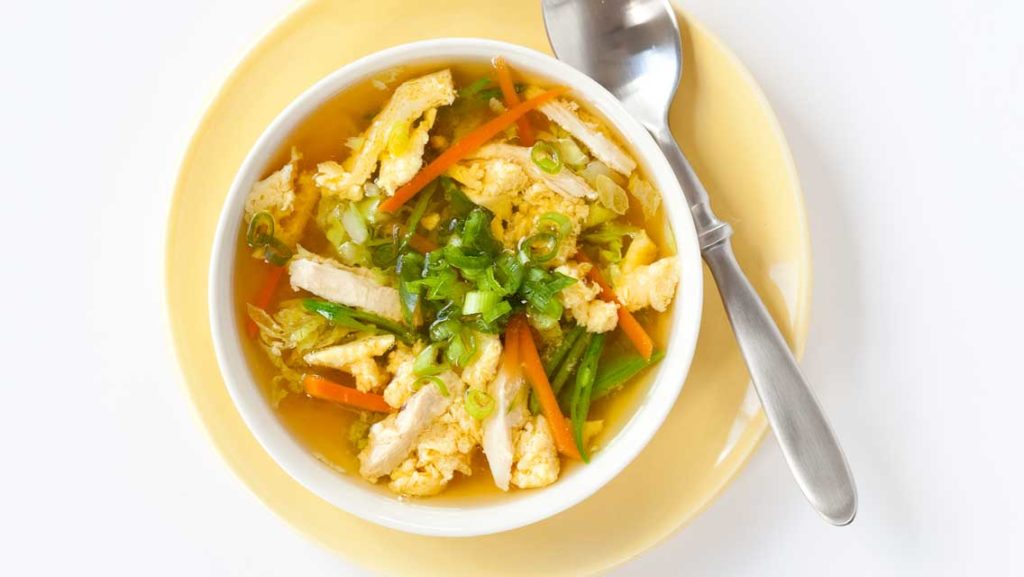
Serves | four
Ingredients
- 6 cups chicken or vegetable stock
- 2 tbs. mirin rice wine
- 1 tbs. minced gingerroot
- 1 carrot, sliced thinly
- 8 snow peas, sliced thinly
- 1 cup shredded Napa cabbage
- 1 cup shredded cooked chicken breast or 1 cup thinly sliced shiitake mushrooms
- 2 tbs. potato starch or corn starch (optional)
- 1 tbs. low-sodium soy sauce or Bragg’s amino acids
- 1 tsp. toasted sesame oil
- 3 large eggs, well beaten
- 2 scallions finely chopped, or 1/2 cup chopped watercress
Directions
- Bring the chicken stock to a simmer with the mirin and ginger.
- Add the carrot, snow peas, cabbage, chicken or mushrooms and simmer until just cooked.
- Mix the potato starch with 1/4 cup cold water and stir into the simmering soup. Simmer until slightly thickened.
- Add the soy sauce and sesame oil and then stir in the eggs. The egg will cook into thin “ribbons.”
- Cook for one to two minutes more and then serve topped with chopped scallions.
What’s in a Yolk?
Apparently, it depends. The darker, sturdier yolk of the free-range egg (bottom) indicates that it is richer in nutrients than the pale, fragile yolk from a conventional egg.
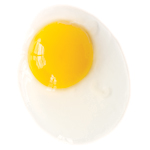
Yolk from a conventionally raised egg.
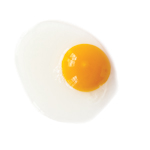
Yolk from a hen that roamed freely outdoors and foraged for food.
“If You Have an Egg, You Have a Meal”
When Marie Simmons was a child, her aunt gave her a beautiful little eggcup. “I just loved that eggcup and eating a soft-cooked egg out of the shell with buttered toast,” she says. Simmons still enjoys simply cooked eggs every morning, but she has also perfected an impressive range of cooking techniques and recipes for making a host of fabulous dishes. A passionate chef and cooking teacher, and a columnist for Bon Appétit for 18 years, Simmons has written nearly 20 cookbooks. Her book The Good Egg: More than 200 Fresh Approaches from Breakfast to Dessert (Houghton Mifflin Harcourt, 2006) won the prestigious James Beard Award for single subject cookbook.
Why did you decide to devote an entire cookbook to eggs?
I first considered the idea in 1998. The egg was being maligned at the time. Doctors were telling people, “Oh, no, no, no. It will raise your cholesterol.” So, even people who had healthy cholesterol weren’t eating eggs, and they were missing out on such a great source of nutrition. As the saying goes: “If you have an egg, you have a meal.”
What would you say to someone who is intimidated by making eggs?
I have a very relaxed attitude toward cooking, so I say: It’s only an egg. Even children can learn to cook a scrambled egg. It’s so simple. We’re not talking soufflés here, and even if your soufflé does fall, so what? It still tastes good because it has good ingredients.
What are the egg dishes all cooks should have in their repertoire?
Scrambled eggs, fried eggs and stuffed eggs. (I know many adults who get all teary eyed over stuffed eggs.) And maybe a frittata, which is similar to an omelet, but easier to make because it can be covered and cooked flat on top of a stove or finished in a hot oven for the last few minutes. If you want to challenge yourself a little bit more, try poached eggs — they’re wonderful.
What common mistake do people make when cooking eggs?
Overcooking them, definitely. I have a great quote from [food scientist] Shirley Corriher in my book: “Gentle heating is the real secret to cooking proteins. . . .” In terms of eggs, the protein becomes rubbery when it’s subjected to too much heat. When the yolks of hard-cooked eggs turn purple, it’s because they’re overcooked. There’s a lot of iron in an egg yolk, and it becomes iron oxide in the presence of high heat.
What is your hands-down favorite way to eat eggs?
I love a simple sunny-side up. I make one or two most mornings and eat them with steamed Swiss chard or spinach with olive oil. I’m not as crazy about hard cooked. I personally find them hard to digest, but they’re a great convenience food. Train your children early to have a hard-cooked egg as a snack; it’s just so convenient and nutritious.|
All of these recipes were created by Betsy Nelson (a.k.a. “That Food Girl”), a Minneapolis-based food stylist and recipe developer.
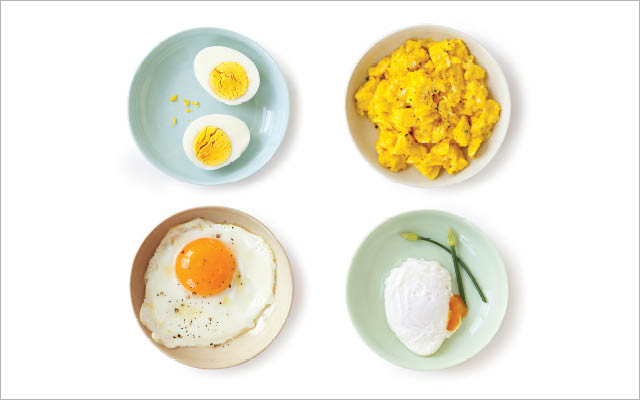
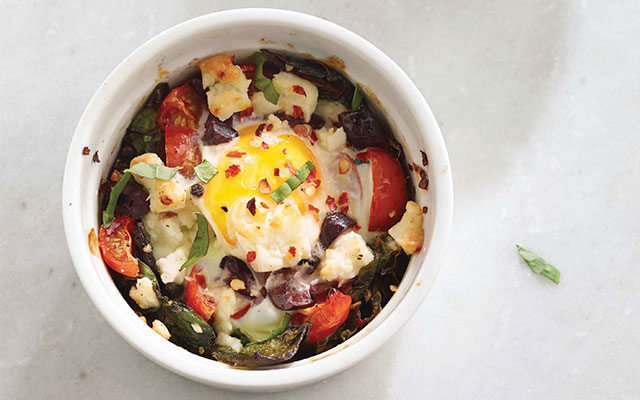

This Post Has 2 Comments
You have shared some amazing facts about eggs in this article. You have also shared some really very good recipes that one can make using eggs. Eggs must be included in the everyday diet as they contain the essential nutrients our body needs to carry out everyday life. Thank you for sharing this informative article with us.
It was interesting to learn that 90% of Americans are deficient in choline, which is found in egg yolks. My husband and I want to start trying different local restaurants to put some variety into our daily routine. Maybe we’ll start by finding a family restaurant where we can get some eggs for breakfast!